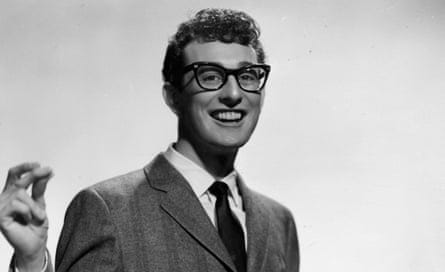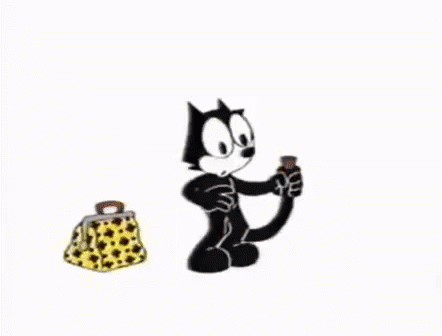It’s 1957 — a big, big year for rock ‘n’ roll.
Enter Buddy Holly. (Real name Charles Hardin Holley.)
Browline glasses. Fender Stratocaster. Songwriter… kinda nerdy tbh.
Buddy was dropped by Decca (same label as Bill Haley & His Comets and Sister Rosetta Tharpe) after his initial recordings were unsuccessful. The arrangement was a bit slow. A bit too country. But the song (above) would be a hit when they sprinkled in a bit more rock.
But to get there, they had to get creative on the business side. Buddy’s savvy manager, Norman Petty, realized the contract had a series of restrictions, but those only applied to companies other than Decca, so he secretly got Buddy signed by two different Decca subsidiaries (smaller labels under the larger parent company). Norman pulled that hat trick off by having Buddy start a new band, The Crickets for one contract and another contract as a solo artist.
(Side note: Notice that The Crickets and The Beatles are oddly similar names…?)
Buddy, recording with Norman and The Crickets, started to use some new recording techniques and adopted more rock ‘n’ roll into his sound. He crafted his success in the studio, blending genre and popular sounds.
It worked. Incredibly well. For both of his contracts.
But what were these new studio techniques? And who invented them?
Standing on the Giant Shoulders of Les Paul
I don’t want the same sounds. I want sounds that have never been heard on Earth. - Les Paul
I love that man. That’s THE DREAM right there. And Les made it happen. He helped turn the musical artist into a musical innovator, broadening the definition and changing the game.
Les Paul (his real name was Lester William Polsfuss!!!!) was arguably the most important technologist and musician of all time.
In the 1930s, Les moved to Chicago, where he played jazz and country music on the radio. By the 1940s, he was a popular guitarist, performing with artists like Bing Crosby and the Andrews Sisters.
He then invented the solid-body electric guitar, now dubbed the Gibson Les Paul — one of the most popular guitars to this day. (Guitarists ranging from My Chemical Romance to Guns N Roses; ZZ Top to Led Zeppelin made the “Les Paul” their instrument of choice.)
Les Paul also invented multitrack recording and “sound on sound” recording, opening up the possibility of layering multiple takes of audio on top of each other. That’s what allows a drummer to play their best take, then the guitarist to play a solo over it until they’re happy. Then after those two finish their work, the vocalist can sing their parts in a silent studio. The sound is placed ontop of the other sounds that came before it.
Before that innovation, the band was playing in the same room aka live. So, Les Paul helped invent the very idea of the “recording.” Keep this in mind when we get to psychedelic rock…
In the final minute of this video, Les Paul and Mary Ford (an incredible guitarist and vocalist that rivals Les’ musical ability… and also his wife) play along to a pre-recorded track, showing the power of multi-tracking live on television:
It was 1953, when I got the idea for the first multi-track recorder, the eight track… My invention was to stack the heads one on top of the other so they were all aligned in the same place, and you could use the same multiple head for recording and playback, and everything would be in sync. It didn’t really become functional until 1957, when we finally re-designed it ourselves to get it right. I worked on it for four years and it cost me about $36,000 total before I ever recorded the first song on it. - Les Paul
(According to the U.S. government’s Bureau of Labor Statistics Bureau of Labor Statistics, his investment would be $425,199.25 in 2024 dollars. Thanks, Les! What a gear head!)
Buddy Holly and the Double-Tracked Lead Vocal
With the invention of “sound-on-sound” recording, artists could make a sound never heard on Earth before: an artist singing along to themselves. A choir of one!
To this day, it’s the most popular vocal effect: “doubling” — singing your part twice and creating a richer, fuller sound.
Here’s one of the first examples in musical history:
When you start listening for vocal doubling, you will hear it everywhere. Almost every. Single. Song.
Why? Thanks these two nerds (geniuses) Buddy and Les. Or should I say Charles and Lester! 🤓
When you listen to John Lennon singing (or anyone inspired by him 🙋), you’re probably hearing vocal doubling. It works wonders in beefing up a vocal and highlighting personality quirks.
Buddy Holly’s Songwriting Innovations
Many artists in this time were singing songs written by someone else, arranged by someone else, and recorded with someone else’s vision. Buddy broke that mold, paving the way for bands like The Beatles to do the same. To be an artist in the truest sense. The sculptor of message, persona, technology, and sound.
In fact, Paul McCartney said he and John Lennon started writing their own songs because of Buddy Holly. Talk about an endorsement.
But why?
His Jazz Influence
Buddy Holly brought diverse influences into rock, including that of George Gershwin and Duke Ellington. If I ever write a jazz history (God help me), they’d get posts onto themselves, but the summary is complexity, structure, key changes, and sophistication. In other words, they brought the bag.
(In musician terms, the bag is the bag of tricks you can reach into. The depth. It’s kinda like Felix’s Magic Bag or a Bag of Holding.)
These dynamic shifts brought the vocabulary of other more established genres and furthered the genre-blending strength of rock to absorb outside influence. Buddy brought contrast and change, orchestral elements, and sudden stops into the genre. He opened the eyes of artists, even with his poor vision! He was especially influential in the United Kingdom… but we’ll get to that!
Roy Orbison (1956)
Needing to raise money for Sun Records, Sam Phillips sold Elvis Presley’s contract to RCA Records for $35,000 in November 1955. And Sam was on the hunt for potential replacements.
He signed Jerry Lee Lewis, Carl Perkins, and Johnny Cash. Cash introduced his friend Roy Orbison, who would become one of the most influential singer-songwriters in rock. Here’s his first charting song, Ooby Dooby, which was one of his most reminiscent of an Elvis record:
Jerry Lee Lewis (1957)
Also in 1957, rock ‘n’ roll’s golden age continued with Jerry Lee Lewis. His roots were in boogie-woogie, blues, and gospel, all of which featured the piano. But rock had been pretty guitar-dominated at this point, and would remain so for much of its history.
Louisiana-born, Jerry Lee Lewis would be discovered by the one-and-only Sam Phillips, and Jerry would make his indelible imprint on rock piano. We already covered his breakout hit in the first post, so here’s his biggest one:
Everly Brothers (1957)
So much of rock to this point had been about the dynamic personality. A solo force of nature like Elvis, Buddy, Jerry, or Chuck.
The Everly Brothers bucked that with tight harmonies and a folk-leaning sound. This was the vibe that merged with artists like Buddy Holly to bring us The Beach Boys, The Beatles, and Simon & Garfunkel:
Their sound also illustrated the crossover appeal of rock. Just as rock was able to include other genres (like Buddy Holly showed with Gershwin and Ellington), rock could be extended outward.
I’ll be bold: This genre interchange invented the genre of Pop.
Elvis as a Film Star
Now on RCA, Elvis’ career continued to soar. The OG rock star was also an OG film star, with his first movie dropping in 1956, Love Me Tender.
Film proved to be a powerful medium to share musical trends alongside the physical attractiveness of its stars. Video killed the radio star. Or did film?
Jailhouse Rock is legitimately iconic. If you have enough time, just watch the whole movie. If not:
It’s easy to watch something like this and think of it in modern terms, but consider how it was presented at the time. Rock ‘n’ roll was intentionally built as a “bad boi” genre to power an emergent teenage class. Some scholars say teenagers were a product of the post-war reality… aka the rock ‘n’ roll target demographic. Cars. Rising wealth. Sheer population numbers.
It’s the boomers, ya’ll.
The Big Bopper (1957)
Speaking on the connection between music and film, J.P. "The Big Bopper" Richardson was a larger-than-life character, who began as a popular radio DJ and personality in Beaumont, Texas.
He brought humor to the rock genre and helped to pioneer the music video. The Big Bopper was credited with the first use of the term "music video" in a January 1959 interview.
Here he is:
Ritchie Valens and La Bamba (1958)
Ritchie Valens (Richard Steven Valenzuela) born in Pacoima, Los Angeles, California, brought the Latino music of his youth into rock ‘n’ roll, once again showing the flexibility of the genre.
“La Bamba” only reached #22 on the charts, but has incredible longevity, in part because it’s a catch rock ‘n’ roll adaptation of a traditional Mexican folk song but also because it’s a total bop.
Rock in Crisis
Rock ‘n’ Roll was a phenomenon, but as a genre, the main players hit a series of scandals that would change the course of history.
Elvis was drafted into the U.S. Army in 1958.
Jerry Lee Lewis faced an uproar in 1958… when it was revealed he married his 13-year-old cousin.
Chuck Berry was accused in 1958 and then imprisoned in 1960 for crimes I have a hard time writing about. Instead, I’ll share what the St. Louis Post-Dispatch read euphemistically:
CHUCK BERRY CHARGED IN TRANSPORTING OF GIRL
A warrant charging Charles (Chuck) Berry, rock and roll singer, with transporting a 14-year-old Indian girl from EI Paso, Tex., to St. Louis for immoral purposes was issued yesterday by United States Commissioner Irvin H. Gamble.
And in 1959, a star-studded lineup performed at the Surf Ballroom in Clear Lake, Iowa. The encore was a cover of Berry’s Brown Eyed Handsome Man, featuring Buddy Holly and the Crickets alongside the Big Bopper, Ritchie Valens, and Dion (from Dion and the Belmonts).
Buddy Holly had chartered a plane to the next gig in Fargo, North Dakota. A sweaty and flu-stricken Big Bopper joined. After the show, Ritchie Valens and Crickets’ guitarist Tommy Allsup flipped a coin.
Ritchie won. The last seat on the plane was his.
The Day the Music Died
From the report:
Because of fluctuation of the rate instruments caused by gusty winds [the pilot] would have been forced to concentrate and rely greatly on the attitude gyro, an instrument with which he was not completely familiar. The pitch display of this instrument is the reverse of the instrument he was accustomed to; therefore, he could have become confused and thought that he was making a climbing turn when in reality he was making a descending turn.
Up was down and down was up, and the pilot, Roger Peterson, mistakenly ran his plane into the ground at 170 miles an hour, killing himself, Buddy Holly, Ritchie Valens, and J.P. "The Big Bopper" Richardson.
Rest in peace.
Wanna explore why I think all this who-did-it-first is worth learning, listen to my podcast on the topic. Spoiler, it’s for forming a fuller background bag to influence the depth of your musical blend. And go ahead and answer the episode poll for posterity:








It is interesting that doubling plays an important part in music.
I love "Miss American Pie"